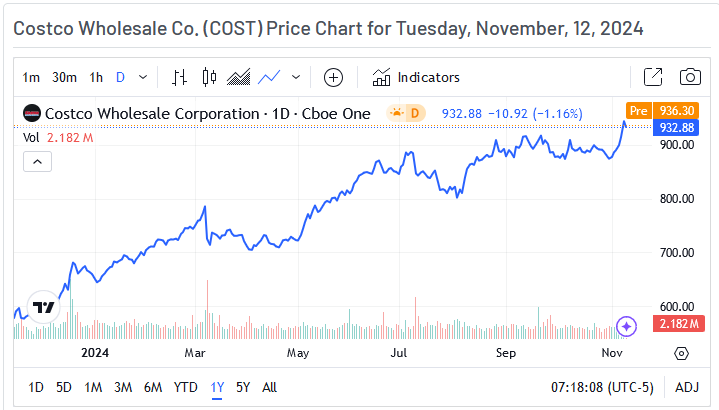Costco Surges to New Heights: Is It Time to Go Long on This Retail Giant?
2024.11.12 09:27
- Costco’s stock momentum remains strong, reaching new highs and up 43% YTD.
- New initiatives like membership price hikes and usage controls could add 4 million members, supporting revenue growth.
- Analysts rate Costco as a Moderate Buy, and net institutional inflows of $17 billion reflect solid confidence in its outlook.
Costco Wholesale (NASDAQ:) has become a remarkable performer in the consumer defensive sector, breaking out to fresh 52-week highs on Friday. The stock is now up almost 43% YTD and nearly 200% over the past five years. As it outpaces the broader market and remains a popular pick among institutional investors, many wonder if now is the right time to go long on Costco.
Shares of Costco Reach New Heights
Costco’s stock reached all-time highs on Friday, adding to its impressive YTD gains. Before this breakout, Costco consolidated around its 20- and 50-day SMAs for several months, creating an attractive setup with a favorable risk-to-reward ratio.
Now that it’s reached new highs, the $900-$920 range will be closely watched for signs of support, as it previously served as a resistance level over recent months. If the stock can hold this level, it may solidify a base for a sustained uptrend, potentially sparking further price increases and momentum.
From a technical perspective, though, the stock may need to cool off before moving higher. Its RSI has reached 73, which signals slight overbought conditions. Following an 8% surge last week, investors should consider waiting for a pullback or another consolidation phase to enter at a more favorable price point. Chasing all-time highs can come with higher risks, so a brief cooldown could improve the overall risk-reward profile for new buyers.
Costco’s Growth Strategy and Financial Health
In its most recent earnings report on September 26, 2024, Costco reported an EPS of $5.15, topping consensus estimates of $5.05 by $0.10. Quarterly revenue increased by 1.0% YoY to $79.70 billion, although it fell slightly short of analyst expectations of $79.91 billion. Costco’s following earnings report is set for December 12, and investors will be watching closely to see if the company can build on its recent performance.
Costco has taken significant steps to increase membership retention and reduce revenue leakage to strengthen revenue growth. A recurring challenge for Costco’s membership model has been unauthorized use, with non-members frequently shopping on borrowed membership cards. To address this, Costco recently implemented a system requiring cardholders to scan membership cards at checkout.
If a membership card doesn’t have the user’s photo, they must provide ID verification. Early results from test locations have shown promising signs of growth, with a double-digit increase in memberships where the scanners were first introduced. Analysts estimate this move could add up to 4 million new members, representing a 5% increase in Costco’s membership base.
In addition to tightening membership controls, Costco raised its membership prices on September 1. The standard membership now costs $65, while the premium Executive membership has increased to $130. The current quarter will reflect the first full quarter of revenue from these changes, and combined with the projected membership growth, these initiatives could be strong revenue drivers heading into 2024.
This and Costco’s ability to provide value to its members continue to support the bullish thesis for long-term growth.
Analysts and Institutional Sentiment Remain Bullish

The general sentiment on Costco is highly favorable, with analysts’ consensus Moderate Buy rating. Of the analysts covering Costco, eighteen have rated it a Buy, while nine have issued Hold ratings. Over the past year, the consensus price target has steadily risen from $585 to $905, reflecting increased optimism about the stock’s growth prospects. However, given that its current trading price is near the target, there may be a limited upside in the short term.
Institutional investors have also shown considerable confidence in Costco’s prospects, as evidenced by notable inflows over the past twelve months. Total (EPA:) institutional inflows reached $27 billion, compared to outflows of only $10 billion, resulting in a net inflow of $17 billion.
This level of investment reflects widespread confidence in Costco’s financial health, management quality, and strategic direction, reinforcing the stock’s positive sentiment.
Original Post








